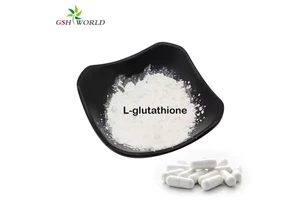What is glutathione?
Glutathione is a widely existing tripeptide containing sulfhydryl (SH) in nature, which mainly exists in the cytoplasm and plays a role in a variety of cellular biochemical functions. It has two forms of reduced (G-SH) and oxidized (G-S-S-G), and it is mostly reduced glutathione under physiological conditions. Glutathione helps maintain normal immune system function and has antioxidant, integrative and detoxifying effects. The sulfhydryl group on cysteine is its active group (often abbreviated as G-SH), which is easy to combine with some drugs, toxins, etc., so that it has an integrated detoxification effect.
Indications and usage of glutathione
1) Indications
1, chemotherapy patients: including cisplatinium chloride, cyclophosphamide, doxorubicin, erythrobiamycin, bleomycin chemotherapy, especially in high-dose chemotherapy;
2, Radiotherapy patients;
3, all kinds of hypoxemia: such as acute anemia, adult respiratory distress syndrome, sepsis, etc.;
4, liver diseases: including viral, drug toxicity, alcohol toxicity (including alcoholic fatty liver, alcoholic liver fibrosis, alcoholic cirrhosis, acute alcoholic hepatitis) and other chemical toxicity caused by liver damage;
5, can also be used for the auxiliary treatment of organophosphorus, amine or nitro compound poisoning;
6, anti-drug toxicity (such as tumor chemotherapy drugs, anti-tuberculosis drugs, psychoneurotic drugs, antidepressants, paracetamol, etc.).
2) Specification
Glutathione for injection: 600 mg
Reduced glutathione for injection: 600 mg
3) Usage and dosage
1. Route of administration:
① Intravenous injection: Dissolve it in water for injection and add 100 mL, 250 ~ 500 mL normal saline or 5% glucose injection for intravenous infusion.
② Intramuscular injection: dissolve it in water for injection and inject it intramuscular.
2. Dosage:
① For chemotherapy patients: 1.5 g/m2 of this product was dissolved in 100 mL normal saline or 5% glucose injection within 15 minutes before chemotherapy drug administration, intravenous infusion within 15 minutes, and 0.6 g of this product was injected into the muscle daily for the 2nd to 5th day.
When using cyclophosphamide (CTX), in order to prevent damage to the urinary system, it is recommended to inject the product intravenously immediately after CTX injection and complete the infusion within 15 minutes;
When using cisplatine for chemotherapy, it is recommended that the dosage of this product should not exceed 35 mg/mg cisplatine, so as not to affect the chemotherapy effect.
② Adjuvant treatment of liver diseases.
For viral hepatitis, 1.2g, qd, iv, 30 days;
Severe hepatitis: 1.2-2.4 g, qd, iv, 30 days;
Active hepatitis: 1.2g, qd, iv, 30 days;
Fatty liver: 1.8g, qd, iv, 30 days;
Alcoholic hepatitis: 1.8 g, qd, iv, 14-30 days;
Drug-induced hepatitis: 1.2-1.8 g, qd, iv, 14-30 days.
③ It is used as an adjuvant to radiotherapy, given after irradiation, with a dose of 1.5 g/m2, or as prescribed by the doctor.
④ Other diseases: such as hypoxemia, 1.5 g/m2 of this product can be dissolved in 100 ml normal saline for intravenous infusion, and 0.3 ~ 0.6 g intramuscular injection every day after improvement.
3, course of treatment: liver disease is generally 30 days for a course of treatment, and other circumstances are determined according to the condition.
Contraindications and adverse reactions
1) Contraindication
It should not be used in people who have allergic reaction to this product.
2) Adverse reactions
Adverse reactions/events detected in post-marketing monitoring include:
- 1, skin and its accessories damage: rash, itching, increased sweating, urticaria, maculopapular, flushing;
- 2, Respiratory system damage: dyspnea, shortness of breath, cough, asthma;
- 3, systemic damage: chest pain, chills, fever, high fever, allergic reaction, anaphylactic shock;
- 4, gastrointestinal damage: nausea, vomiting, abdominal pain;
- 5, nervous system damage: dizziness, headache;
- 6, drug site damage: injection site pain, injection site phlebitis;
- 7, Cardiovascular system damage: palpitations.
3) Precautions
- 1, Use this product in the hospital under the supervision of a doctor.
- 2, must be completely dissolved before injection, appearance clear, colorless.
- 3, Keep out of reach of children.
- 4, such as rash, pale face, drop in blood pressure, abnormal pulse and other symptoms during the drug should be stopped immediately.
- 5, Intramuscular injection is only used when this route is needed, and repeated injection at the same site should be avoided.
- 6, The drug can cause anaphylactic shock. The doctor should ask the patient about the history of drug allergy, closely monitor the process of medication, if asthma, chest tightness, shortness of breath, dyspnea, palpitations, sweating, blood pressure drop and other symptoms and signs, should immediately stop the drug and timely treatment.
- 7, Use with caution in patients with a history of asthma attack.








